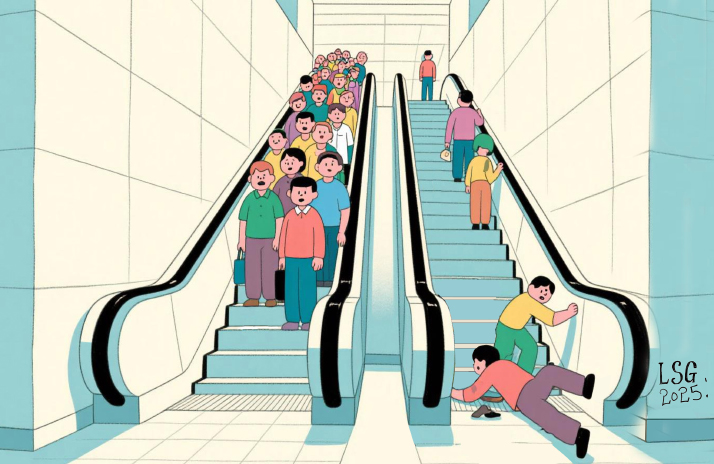| China |
| Reversing outdated escalator etiquette | |
|
|
 LI SHIGONG
Recently, small footprint stickers have appeared on escalators in some subway stations in Beijing. Subway operators say these "footprints" are placed there to remind passengers they don't have to "stand on the right and walk on the left" of escalators but can instead stand side-by-side with another passenger. "Stand on the right and walk on the left" was once regarded as a symbol of caring for others, with escalator users standing on the right side to leave the left side open for people in a hurry. After years of widespread adoption, the inherent safety flaws of this convention have become increasingly apparent and are triggering doubts about its possible merits. Jiang Debin (Workers' Daily): Escalators were not initially designed for pedestrian traffic, so walking on them can easily lead to imbalance or even accidents. Furthermore, prolonged weight on a single side can hasten the deterioration of an escalator's mechanics, creating a greater possibility of equipment failure and potential safety hazards. In 2018, Beijing Subway dropped the "right and left" recommendation and now encourages passengers to hold the handrail and watch their step on escalators. Other big cities including Shanghai, Guangzhou, Nanjing and Chengdu have also abandoned "stand on the right and walk on the left" guidance. This seemingly tiny adjustment reflects consideration for escalator safety. Of course, long-held habits, particularly those regarded as proper etiquette, are hard to break. The cute design of the tiny footprint stickers in Beijing is meant to use gentle visual language to replace rigid safety reminders, allowing passengers to gradually adopt a new concept of civility. This experience is worth emulating in more places. Furthermore, the significance of the new footprint stickers, as well as the safety hazards of "standing on the right and walking on the left" should be more widely promoted through a variety of channels to gradually increase public awareness and acceptance of the new guidance. Zhao Zhijiang (ThePaper.cn): Despite clear messaging in many cities that "stand on the right and walk on the left" is neither safe nor necessary, many people have not adapted to the new guidance yet, requiring subway operators to use signage to remind them. The downsides of the "right and left" guidance are apparent, but it has already become ingrained in many people's minds. Even those who already recognize its potential risks often feel pressured to comply, fearing scrutiny from others. Some passengers, while walking up the escalator, demand that other passengers make way, sometimes even rudely pushing those in front of them aside. This places moral pressure on those "blocking the way," who feel they are hindering others' passage. Thus the "right and left" guidance is not only unsafe but also reduces overall efficiency. The correct posture is to stand side-by-side with another passenger and hold on tight. The old escalator guidance was initially intended to benefit passengers in a hurry, but how much time can be saved on subway and shopping mall escalators? Why should the rightful interests of the majority be compromised to cater to the needs or preferences of a small fraction? In this sense, the yellow footprint stickers on escalators undeniably help reverse an improper old habit, as well as give a subtle prompt: It's acceptable to stand side-by-side on escalators and you don't need to feel guilty about doing so. BR Copyedited by G.P. Wilson Comments to panxiaoqiao@cicgamericas.com |
|
||||||||||||||||||||||||||||
|